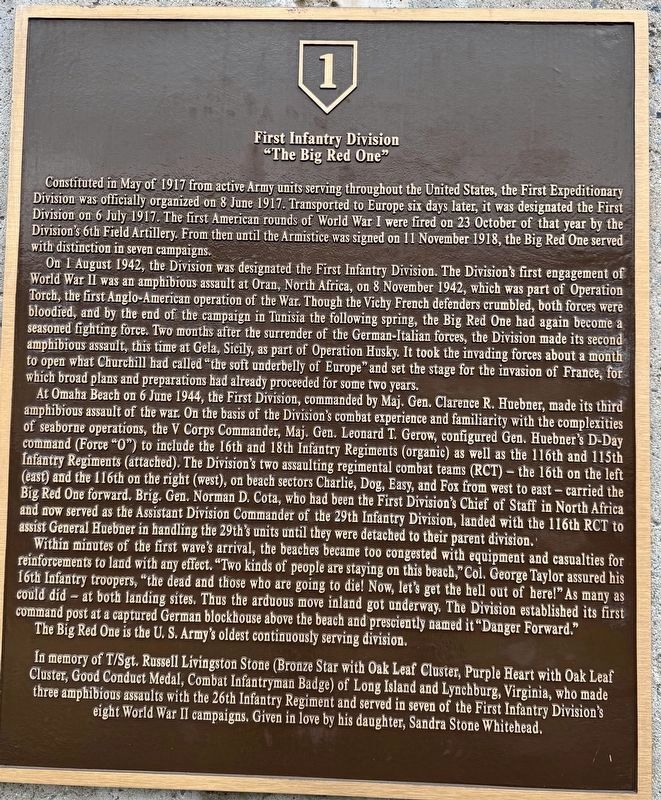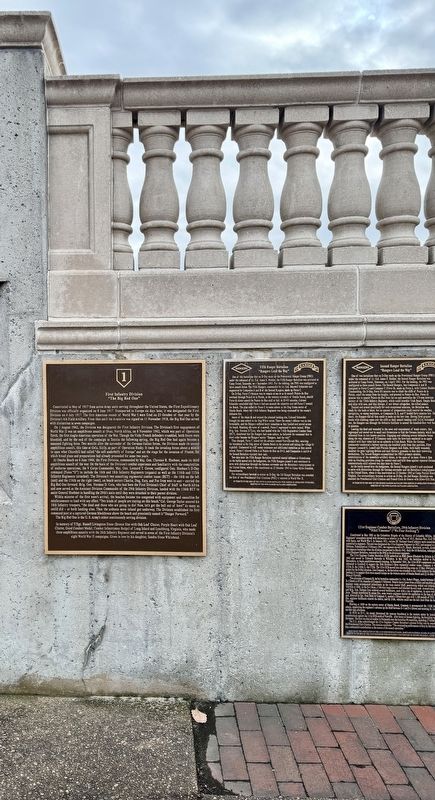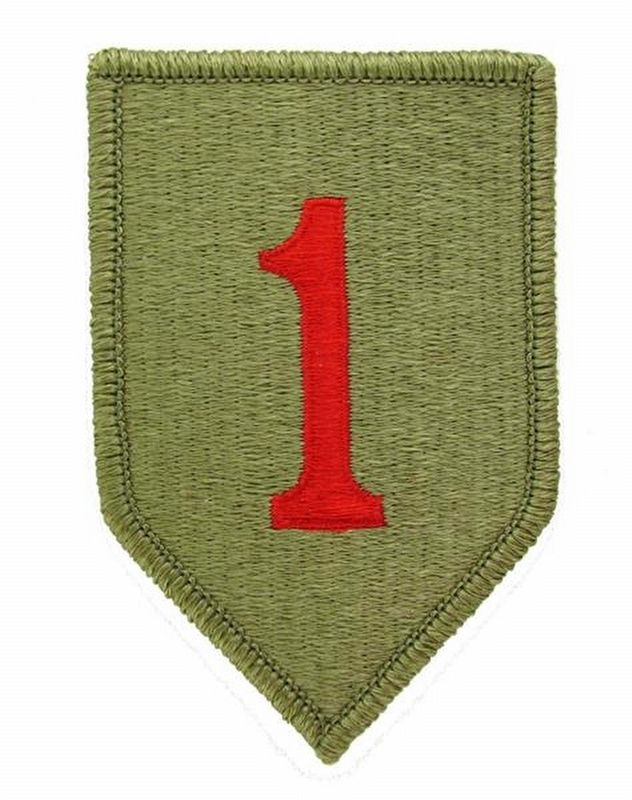Bedford in Bedford County, Virginia — The American South (Mid-Atlantic)
First Infantry Division
“The Big Red One”
— National D-Day Memorial —
On 1 August 1942, the Division was designated the First Infantry Division. The Division's first engagement of World War Il was an amphibious assault at Oran, North Africa, on 8 November 1942, which was part of Operation Torch, the first Anglo-American operation of the War. Though the Vichy French defenders crumbled, both forces were bloodied, and by the end of the campaign in Tunisia the following spring, the Big Red One had again become a seasoned fighting force. Two months after the surrender of the German-Italian forces, the Division made its second amphibious assault, this time at Gela, Sicily, as part of Operation Husky. It took the invading forces about a month to open what Churchill had called "the soft underbelly of Europe" and set the stage for the invasion of France, for which broad plans and preparations had already proceeded for some two years.
At Omaha Beach on 6 June 1944, the First Division, commanded by Maj. Gen. Clarence R. Huebner, made its third amphibious assault of the war. On the basis of the Division's combat experience and familiarity with the complexities of seaborne operations, the V Corps Commander, Maj. Gen. Leonard T. Gerow, configured Gen. Huebner's D-Day command (Force "O") to include the 16th and 18th Infantry Regiments (organic) as well as the 116th and 115th Infantry Regiments (attached). The Division's two assaulting regimental combat teams (RCT) - the 16th on the left (east) and the 116th on the right (west), on beach sectors Charlie, Dog, Easy, and Fox from west to east - carried the Big Red One forward. Brig. Gen. Norman D. Cota, who had been the First Division's Chief of Staff in North Africa and now served as the Assistant Division Commander of the 29th Infantry Division, landed with the 116th RCT to assist General Huebner in handling the 29th's units until they were detached to their parent division.
Within minutes of the first wave's arrival, the beaches became too congested with equipment and casualties for reinforcements to land with any effect. "Two kinds of people are staying on this beach," Col. George Taylor assured his 16th Infantry troopers, "the dead and those who are going to die! Now, let's get the hell out of here!" As many as could did - at both landing sites. Thus the arduous move inland got underway. The Division established its first command post at a captured German blockhouse above the beach and presciently named it "Danger Forward."
The Big Red One is the U.S. Army's oldest continuously serving division.
In memory of T/Sgt. Russell Livingston Stone (Bronze Star with Oak Leaf Cluster, Purple Heart with Oak Leaf Cluster, Good Conduct Medal, Combat Infantryman Badge) of Long Island and Lynchburg, Virginia, who made three amphibious assaults with the 26th Infantry Regiment and served in seven of the First Infantry Division's eight World War II campaigns. Given in love by his daughter, Sandra Stone Whitehead.
Erected by National D-Day Memorial.
Topics and series. This memorial is listed in these topic lists: War, World I • War, World II. In addition, it is included in the U.S. National D-Day Memorial series list. A significant historical date for this entry is June 6, 1944.
Location. 37° 19.854′ N, 79° 32.158′ W. Marker is in Bedford, Virginia, in Bedford County. Memorial can be reached from Overlord Circle, 0.4 miles west of Burks Hill Road. The Marker is located on the grounds of the National D-Day Memorial. Touch for map. Marker is at or near this postal address: 3 Overlord Circle, Bedford VA 24523, United States of America. Touch for directions.
Other nearby markers. At least 8 other markers are within walking distance of this marker. Fifth Ranger Battalion (here, next to this marker); Military Police (MP) Platoons (here, next to this marker); 238th Engineer Combat Battalion (here, next to this marker); Second Ranger Battalion (here, next to this marker); 320th Anti-Aircraft Balloon Battalion (here, next to this marker); 121st Engineer Combat Battalion, 29th Infantry Division (here, next to this marker); Sixth Naval Beach Battalion (here, next to this marker); 5th Engineer Special Brigade (here, next to this marker). Touch for a list and map of all markers in Bedford.
Also see . . .
1. 1st Infantry Division history - Battle of Normandy. (Submitted on February 25, 2024, by Brandon D Cross of Flagler Beach, Florida.)
2. National D-Day Memorial. (Submitted on February 25, 2024, by Brandon D Cross of Flagler Beach, Florida.)
Credits. This page was last revised on February 28, 2024. It was originally submitted on February 25, 2024, by Brandon D Cross of Flagler Beach, Florida. This page has been viewed 38 times since then. Photos: 1, 2, 3. submitted on February 25, 2024, by Brandon D Cross of Flagler Beach, Florida. • Andrew Ruppenstein was the editor who published this page.


